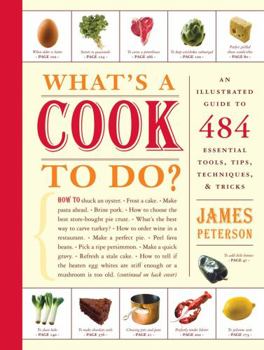What's a Cook to Do?: An Illustrated Guide to 484 Essential Tips, Techniques, and Tricks
Select Format
Select Condition 
Book Overview
From America's favorite cooking teacher, multiple award-winner James Peterson, an invaluable reference handbook. Culinary students everywhere rely on the comprehensive and authoritative cookbooks... This description may be from another edition of this product.
Format:Paperback
Language:English
ISBN:1579653189
ISBN13:9781579653187
Release Date:April 2007
Publisher:Artisan Publishers
Length:432 Pages
Weight:1.56 lbs.
Dimensions:2.0" x 6.0" x 8.0"
Related Subjects
Baking Techniques Non-Fiction Cooking Cooking Culinary Arts & Techniques Holiday Cooking ReferenceCustomer Reviews
3 ratings
Recommended
Published by Thriftbooks.com User , 16 years ago
This is really an instructional book in 'tips' format. It's not really a collection of 'helpful hints.' To me, it resembles books such as such as Craig Claiborne's Kitchen Primer or Julia Child's Kitchen Wisdom, or even Anne Willan's The Good Cook (a much larger book). Even if you already know how to chop an onion or peel a tomato, this book can be extremely helpful. For one tip, Peterson categorizes herbs as either watery and oily. For another, he tells you what type of pork chops should be braised rather than sauteed. His advice can be unconventional (telling you to skip the browning stage when making a stew) or middlebrow (suggesting the use of jarred mayonnaise as a starter when making homemade). Recipes are embedded throughout, although they're so under-written as to barely qualify as recipes. This is actually beneficial, as it encourages you to develop your cooking instincts and think for yourself. That being said, I have found I wouldn't mind a bit more information when trying some of his baking recipes. Nonetheless, this is a great book, and I wish it were written years ago.
What a cool little book!
Published by Thriftbooks.com User , 16 years ago
This is a very helpful book, full of great ideas, photographs and, as stated, 484 essential tips, etc. I think any cook or chef would find this a great addition to a kitchen library. The format is also convenient - not too big, and easy to read.
Best in breed among cooking tip books. Buy it now!
Published by Thriftbooks.com User , 17 years ago
`What's a Cook to Do?' by cooking teacher extraordinare, James Peterson is the best handbook of cooking techniques I have seen due to its excellent organization, the quality of the advice, and the great good humor of the author. This ranking includes placing it above a similar work, `Julia's Kitchen Wisdom' by the legendary Julia Child, which is no mean feat. The book falls into a rather small niche of culinary works. It is not a `scientific' work like those from Alton Brown (`I'm Just Here for the Food') and Shirley Corriher (`Cookwise'). It is also not a formal manual of professional cooking techniques like Jacques Pepin's `Complete Techniques' or the author's own `Essentials of Cooking'. The best recent book in it's category is the issue from `Fine Cooking' magazine, `How to Break an Egg', which I liked quite a bit, but Peterson's book is better. If you are a `foodie', you will want both, but if you feel you only want one, Peterson's is the one to get. The major reason lies in the fact that as in all of Peterson's books, he writes with the kind of good humored common sense which engenders trust in his advice, even more than his impressive resume as a chef, author, and teacher. The best symptom of this common sense is revealed when his advice is simply more accurate than that offered in `How to Break an Egg' for example. Both books correctly warn against leaving a stock in the dangerous temperature range that encourages bacterial growth. But, on two points, Peterson's advice is superior. First, he more correctly identifies the upper range of the danger zone to be 140 degrees Fahrenheit rather than `Fine Cooking's 120 degrees. Second, Peterson points out that as long as the stock is above the danger point, applying coolant is a waste of ice. The trick is to apply the cooling just as the stock reaches the danger point, in order at that time to bring it down as quickly as possible to the safe 40 degrees Fahrenheit. Speaking of stocks, Peterson visits the old chestnut about freezing stocks in ice cube trays and storing them in the freezer. The problem with that is that to maintain a reasonably sized stockpile, you need a pretty large freezer. His solution is to have the stocks reduced to a light syrup, at about 1/15th of their original volume, then freeze the goodies in trays for making miniature ice cubes, so a teaspoon sized cube will reconstitute to more than a quarter of a cup of stock. Like Julia Child's little book, Peterson's work has a fair share of complete recipes for those really important skills which you should really learn by heart. This includes recipes for stocks, biscuits, crepes, omelets, marinara sauce, pesto, pie and tart pastry, meringue, breaded veal cutlets, and cheese puffs. While many of these recipes may not be as complete as you may find in `Mastering the Art of French Cooking' or even Peterson's other books, they almost always bring out the essentials, and sometimes, a few surprises. In the summary of the meringue te




